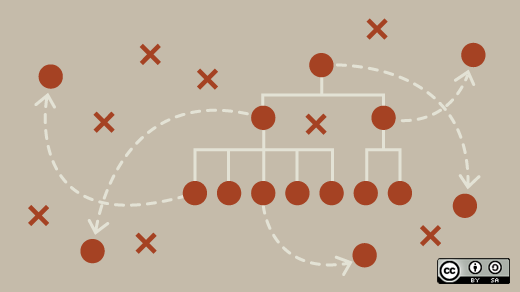When I began studying sales training and giving sales seminars, I realized I was discovering a few basic principles. These principles were applicable anywhere in the world—and they were as true in the past as they will be in the future. They pertained to fundamental aspects of my work: Finding customers, meeting customers, learning what customers want, choosing a product or service that would satisfy customers' needs, etc. One can enact these principles in various, situational ways. But the principles themselves are constant.
Open organizations operate according to principles, too: transparency, inclusivity, adaptability, collaboration, and community. We can relate those principles to specific behaviors that propel the principles forward and keep them firmly rooted as part of the organization's culture.
Doing this would involve moving from abstract principles to concrete tasks. That's always a difficult challenge.
No one will outwardly say they want to hide things; they'll espouse transparency. No one will outwardly say they want to exclude people; they'll champion inclusivity. No one will outwardly say they want to give up when adjustments are required; they'll argue in favor of adaptability. These are principles with which almost no one disagrees in theory. The problem, of course, is execution.
So how can people in open organizations move from principles to sets of tasks or behaviors? And what if we could systematize those principles so thoroughly that we could translate them into algorithms that guide and gauge behavior?
Ray Dalio and his colleagues at Bridgewater Associates have undertaken that challenge—and with interesting results. In Dalio's recent book, Principles: Life and Work, readers can learn more about the ways that Bridgewater develops and implements specific management tools for improving decision making and guiding behaviors.
In this article, the second installment of a two-part review of Principles, I'll explore those tools and the thinking behind them, because they stand to be quite useful for anyone interested in developing an open organization.
Building machines
The difference between principles and actions is a wishes-to-behavior gap Dalio has observed. In the first part of this review, I explained a few of Bridgewater's more abstract principles—things like "idea meritocracy," "radical truth," and "radical transparency." Transforming those principles into actual behaviors, and then setting up an environment that promotes and supervises those behaviors, is what will determine the greatest success in their application and ongoing improvement. Principles advocates both creating the right working environment and applying "tools" to supervise specific tasks with real-time feedback.
Dalio says those "tools" are part of larger systems he calls "machines." For Dalio, the term "machine" defines an entire management process, including step-by-step actions for execution. He advocates constantly working on the machines that are central to your organizational success.
Dalio stresses that machines work on things you can control. Here's an example: A salesman's actual sales amount is out of his control; the competitiveness of the product and the desires of the customer are factors that play into this amount, and the salesman can't really control either of them. But he can control what he does and how well he does it; he can control the "sales machine" he executes when trying to do his work. He can develop and effective process—a series of tasks and certain behaviors that accompany them—and improve on it.
Each task involves causes and effects, and perfecting your machines means becoming aware of these. How will one process influence the next process (and so on)? Anything that happens in an organization is usually caused or triggered by something. What is that "something"? Returning to our example salesman: The larger the number and better the quality of potential customers a salesman gathers, the more meetings he can have. The more meetings he has, the more he can determine what people need. The more needs he determines; the more product recommendations he can give. And so on. That's the sales "machine."
Locating triggers
To fine-tune a machine, you'll need to identify certain events that actually produce the movements between various steps in a process. Over the years, I've called these events "triggers."
Here's one simple example of a trigger: Whenever we finish a box of cereal in my home, we cut a piece of the package and place it on our kitchen counter, then throw the rest of the box away. Every time any one of us sees that square, we receive a trigger to go buy cereal.
Here's another: When I was traveling a lot, I needed to pack bags regularly, and had to decide every time what I would need for the trip. So, I decided to make a list of everything I could possibly need, including my required business documents. This list went from handwritten notes, to a list in a word processor, to a checklist on a spreadsheet with boxes I could check as I packed. After each trip, I reviewed the checklist and decided what was missing and/or what could be deleted. That list has become a valuable tool for me—a series of triggers for what to pack.
The important thing about triggers is that, eventually, you don't think about them; you just do them every time you tackle an assignment or execute a task. Triggers should also be repeatable across different groups or contexts (I told some colleagues about my pre-travel checklist, for example, and they started using and editing it for their business travel).
Imagine taking these examples above and computerizing them—making algorithms that automate various triggers, even creating entire software applications around these processes. By doing this, you've taken an abstract concept (like "radical transparency"), identified the "machine" or process that represents "good" transparency behaviors, and isolated the various "triggers" that cause people to perform those beneficial behaviors (or not!).
You've taken theory and turned it into executable plans.
Tools and apps
So let's review some of Bridgewater's tools and apps for reinforcing cultural values, as Dalio describes them in Principles.
Dot Collector
Participants continuously record assessments of each other by giving them "dots," positive or negative, on a number of attributes. These dots are laid out in a grid that updates dynamically, so that everyone in the conversation can see one another's thinking as the meeting progresses. Seeing things through everyone's eyes naturally causes most people to adopt a higher-level view, with which they recognize that their own perspective is just one of many—so they ask themselves which criteria are best for deciding how to resolve the issue at hand. By taking data on what everyone in the room is like, the app is able to give people individualized coaching, which is especially important when their own opinions are unlikely to be right. The Dot Collector system notifies people automatically if they disagree with the believability-weighted majority on a given issue, and then gives them guidance on the appropriate steps to take to resolve that disagreement in an evidence-based way; it enables, in effect, believability-weighted voting. The votes are on both equal-weighted and believability-weighted bases, not just simple majorities. You can see more details on Dot Collector in Ray Dalio's TED talk.
Baseball Cards
This is a collection of data on all members of an organization—not just for meetings, in the case of Dot Collector. Baseball Cards list up reviews, tests, choices made, etc., for everyone in the organization. All this information is analyzed algorithmically (based on stress-tested logic) in order to create a strong impression, image, or picture of what certain people are like. These impressions are then captured on Baseball Cards, a simple way of presenting a person's strengths and weaknesses and the evidence behind them (just like a professional baseball player's card). They help develop objectively a person's authority on a given subject. At Bridgewater, people can challenge the ratings on their cards and present evidence-based arguments for changes.
The issue log
The "issue log" is primarily for recording mistakes and learning from them. It's a place to log problems the organization needs to solve (not to be cruel and hurtful to people when they make mistakes). The faster the issue becomes transparent, the quicker it will be solved. Here again, an environment that encourages exposing mistakes is important. (We did something similar when I was in the automobile industry: I taught automotive dealership service department personnel about recording "comebacks," repairs on vehicles that have to be done twice, because the problem was not solved the first time. "Comebacks" are killers of service department productivity. There are a wide range of reasons why a vehicle is not repaired the first time, so by analyzing it, a solution for the future can be found.)
The pain button
The moment someone experiences pain is the best time for them to record what the pain is like—but it's a bad time to reflect on it, because it's hard to keep a clear head at that time. So this particular app is designed to let people record the emotions they are feeling (anger, disappointment, frustration, worry, rejection, etc.) as they feel them, then come back at a later time to reflect on that pain using guided reflection questions. The app also displays the frequency of the pain, the causes of the pain, and whether the actions an employee took afterward were productive. The tool creates a template for looping toward improvement that everyone can see. It allows you to decide to share your entries with others or keep them to yourself. Some people describe the "pain button" as something that's like having a psychologist in your pocket. At Bridgewater, Pain + Reflection = Progress.
The dispute resolver
Disputes need clear paths toward resolution. This app provides a map to resolving disagreements in an idea-meritocratic way. It asks a series of questions to make sure all important information necessary for making the decision has been presented. It locates all the believable people in the decision-making group. It determines if the issue must be taken to a higher management level. It makes sure everyone knows the other members' different points of view. Speed in decision-making can be a real competitive advantage, and this tool can be very helpful in that regard.
An app for that
How might we begin applying this type of thinking to open organization principles?
First, we'd need to identify specific behaviors, attributes, and actions that express the characteristics of open organization (transparency, inclusivity, adaptability, collaboration, and community). Then, we'd need to establish measurements for each behavior. Finally, we'd have to develop an app that exposes and supervises that behavior.
Take "transparency," in Figure 1, for example:
|
Principle example |
Behavior example |
Measurement example |
Apps to supervise behaviors |
|
Transparency |
Record all meetings to get broader exposure. |
Was enough information presented (scale of 1-10)? Did everyone speak their minds (1-10)? |
Asks each member the question, "Was enough information presented?" Answer on a scale of 1-10. Were all members' opinions presented (1-10)? With the weighted average, the App will explain what to do next. |
Figure 1
If Fitbit watches can be so popular supervising a person's daily movement activities, and GPS systems can get people from place to place without them having to do a lot of thinking, so too can apps help us build open organizations. We just need to move from principles to actions.
Subscribe to our weekly newsletter to learn more about open organizations.






1 Comment